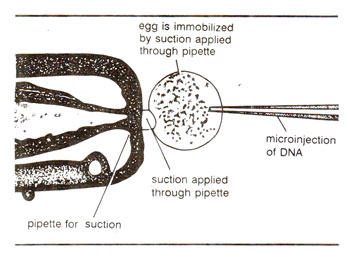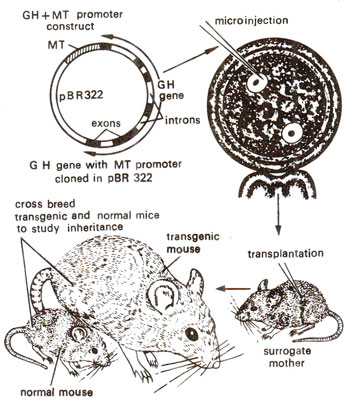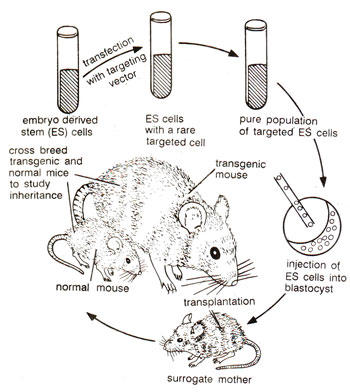
Fig. 42.1. Microinjection of foreign DNA into a fertilized egg for transfer of a gene leading to the production of transgenic animals.

Fig. 42.2. Different steps in the production of transgenic mice through microinjection of eggs.
In bacteria and other microbes, or even in higher plants, the uptake of genes by cells is often described as
'transformation'. In animals, this term is replaced by the term
'transfection' because the term transformation is used in animals to describe phenotypic alteration in cells. Transfection or gene transfer in animals can be carried out at the cellular level and the transfected cells may be used for a variety of purposes including the following : (i) production of chemicals and pharmaceutical drugs; (ii) study of structure and function of genes and (iii) production of transgenic animals for increased milk production, increased growth rate of livestock and fish, etc., large scale production of valuable proteins (to be extracted from milk, urine and blood ; this is described as
'molecular farming') and for improvement of wool in sheep. The transfection methods may employ the fertilized eggs/embryos or the cultured cells. The technique and the purpose of transfection may differ in the two cases.
Transfer of genes to fertilized eggs or embryos. The transfection of fertilized egg may involve transfer of whole nuclei, whole chromosomes (or fragments) or DNA segments, (i) For the
transfer of whole nuclei, the egg cells are treated with
cytochalasin-B and subjected to centrifugation causing enucleation (nucleus is removed). Incubation of desirable karyoplasts with these enucleated eggs leads to the transfer of whole nuclei in presence of polyethylene glycol (PEG); (ii) For
transfer of whole chromosomes, the chromosomes are first isolated from metaphase cells by hypotonic lysis and may be fractionated using density centrifugation or
flow cytophotometry. Individual chromosomes or fragments thus isolated are then incubated with whole cells (eggs) for incorporation of chromosomes into nuclei; (iii)
Microinjection of DNA segments into fertilized eggs is the most commonly used method (Fig. 42.1). Several hundred copies of the DNA segment are utilized and after stable integration, the eggs are used for getting transgenic animals. This method is commonly used for the production of transgenic mice (Fig. 42.2).

Fig. 42.1. Microinjection of foreign DNA into a fertilized egg for transfer of a gene leading to the production of transgenic animals.

Fig. 42.2. Different steps in the production of transgenic mice through microinjection of eggs.

Fig. 42.3. Transfection of stem cells and injection of derived stem cells into blastocyst, leading to the production of transgenic
Transfer of genes to cultured cells.
Transfection of cultured cells (usually stem cells; stem cells are undifferentiated precursor cells) is often attempted for purposes of gene therapy, etc. but can also be used for production of transgenic plants. Gene transfer to cultured cells can be achieved either through the use of retroviruses and other viruses as vectors or by direct delivery of DNA by any of the following methods (Fig. 42.3) : (i)
coprecipitation of DNA with calcium phosphate; (ii) use of complexes, of
DNA with polycations or lipids; (iii)
electroporation (a technique, where cell membrane is made more permeable by electric shocks); (iv) use of gold or tungsten particles coated with DNA and accelerated to a high speed using a
particle gun (see later); (v)
microinjection of DNA using micro-manipulator and (vi) use of
liposomes or
sphaeroplasts, which ar vesicles carrying DNA. In future more efficient methods of gene transfer to cultured cells in animals will become available.

Fig. 42.3. Transfection of stem cells and injection of derived stem cells into blastocyst, leading to the production of transgenic









